Savoy Hotel's Employee Attraction and Retention Challenges Report
VerifiedAdded on 2022/09/14
|10
|2670
|16
Report
AI Summary
This report provides a comprehensive analysis of the employee attraction and retention issues faced by The Savoy Hotel in London, UK. It begins with an introduction to the problem and the hotel's context, followed by an examination of the environmental forces impacting the hospitality sector, including demographic, economic, sociocultural, technological, and political factors. The report then delves into the specific challenges The Savoy Hotel faces concerning rewards and retention, such as skill shortages, salary dissatisfaction, and lack of job rotation. It further explores the impact of these challenges on employee performance and turnover. The core of the report presents recommendations for addressing these challenges, including competitive remuneration strategies, training and development programs, improved recruitment practices, and the implementation of total rewards programs. The report concludes by emphasizing the importance of effective HR strategies for the success of the organization. The report is based on the provided assignment brief which focuses on assessing the reward policy and options for a chosen organization within the hospitality sector.

HR
Paraphrase This Document
Need a fresh take? Get an instant paraphrase of this document with our AI Paraphraser

Contents
Introduction.................................................................................................................................................2
Environmental forces...................................................................................................................................2
Challenges...................................................................................................................................................4
Recommendation.........................................................................................................................................5
Conclusion...................................................................................................................................................7
Reference....................................................................................................................................................8
Introduction.................................................................................................................................................2
Environmental forces...................................................................................................................................2
Challenges...................................................................................................................................................4
Recommendation.........................................................................................................................................5
Conclusion...................................................................................................................................................7
Reference....................................................................................................................................................8
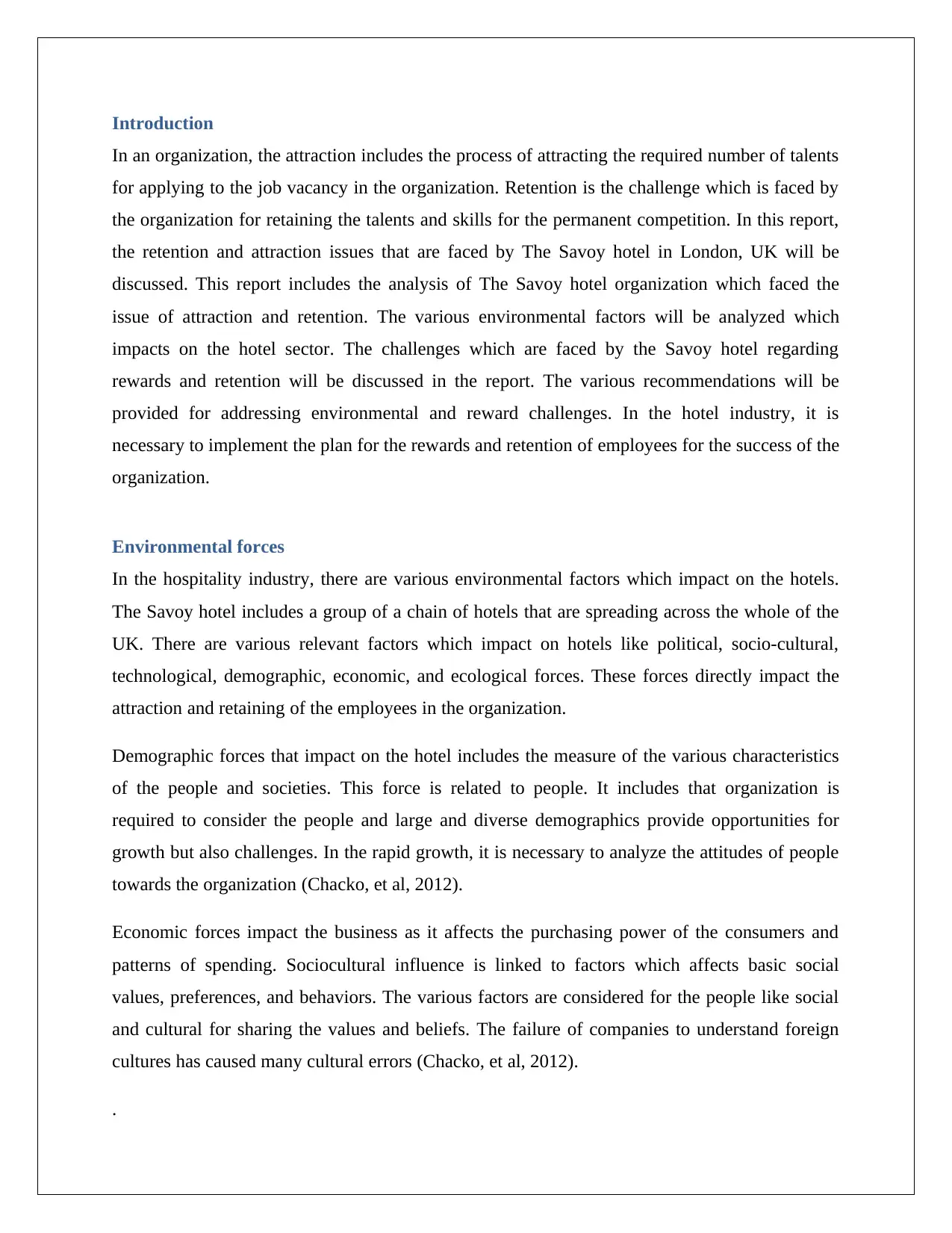
Introduction
In an organization, the attraction includes the process of attracting the required number of talents
for applying to the job vacancy in the organization. Retention is the challenge which is faced by
the organization for retaining the talents and skills for the permanent competition. In this report,
the retention and attraction issues that are faced by The Savoy hotel in London, UK will be
discussed. This report includes the analysis of The Savoy hotel organization which faced the
issue of attraction and retention. The various environmental factors will be analyzed which
impacts on the hotel sector. The challenges which are faced by the Savoy hotel regarding
rewards and retention will be discussed in the report. The various recommendations will be
provided for addressing environmental and reward challenges. In the hotel industry, it is
necessary to implement the plan for the rewards and retention of employees for the success of the
organization.
Environmental forces
In the hospitality industry, there are various environmental factors which impact on the hotels.
The Savoy hotel includes a group of a chain of hotels that are spreading across the whole of the
UK. There are various relevant factors which impact on hotels like political, socio-cultural,
technological, demographic, economic, and ecological forces. These forces directly impact the
attraction and retaining of the employees in the organization.
Demographic forces that impact on the hotel includes the measure of the various characteristics
of the people and societies. This force is related to people. It includes that organization is
required to consider the people and large and diverse demographics provide opportunities for
growth but also challenges. In the rapid growth, it is necessary to analyze the attitudes of people
towards the organization (Chacko, et al, 2012).
Economic forces impact the business as it affects the purchasing power of the consumers and
patterns of spending. Sociocultural influence is linked to factors which affects basic social
values, preferences, and behaviors. The various factors are considered for the people like social
and cultural for sharing the values and beliefs. The failure of companies to understand foreign
cultures has caused many cultural errors (Chacko, et al, 2012).
.
In an organization, the attraction includes the process of attracting the required number of talents
for applying to the job vacancy in the organization. Retention is the challenge which is faced by
the organization for retaining the talents and skills for the permanent competition. In this report,
the retention and attraction issues that are faced by The Savoy hotel in London, UK will be
discussed. This report includes the analysis of The Savoy hotel organization which faced the
issue of attraction and retention. The various environmental factors will be analyzed which
impacts on the hotel sector. The challenges which are faced by the Savoy hotel regarding
rewards and retention will be discussed in the report. The various recommendations will be
provided for addressing environmental and reward challenges. In the hotel industry, it is
necessary to implement the plan for the rewards and retention of employees for the success of the
organization.
Environmental forces
In the hospitality industry, there are various environmental factors which impact on the hotels.
The Savoy hotel includes a group of a chain of hotels that are spreading across the whole of the
UK. There are various relevant factors which impact on hotels like political, socio-cultural,
technological, demographic, economic, and ecological forces. These forces directly impact the
attraction and retaining of the employees in the organization.
Demographic forces that impact on the hotel includes the measure of the various characteristics
of the people and societies. This force is related to people. It includes that organization is
required to consider the people and large and diverse demographics provide opportunities for
growth but also challenges. In the rapid growth, it is necessary to analyze the attitudes of people
towards the organization (Chacko, et al, 2012).
Economic forces impact the business as it affects the purchasing power of the consumers and
patterns of spending. Sociocultural influence is linked to factors which affects basic social
values, preferences, and behaviors. The various factors are considered for the people like social
and cultural for sharing the values and beliefs. The failure of companies to understand foreign
cultures has caused many cultural errors (Chacko, et al, 2012).
.
⊘ This is a preview!⊘
Do you want full access?
Subscribe today to unlock all pages.

Trusted by 1+ million students worldwide
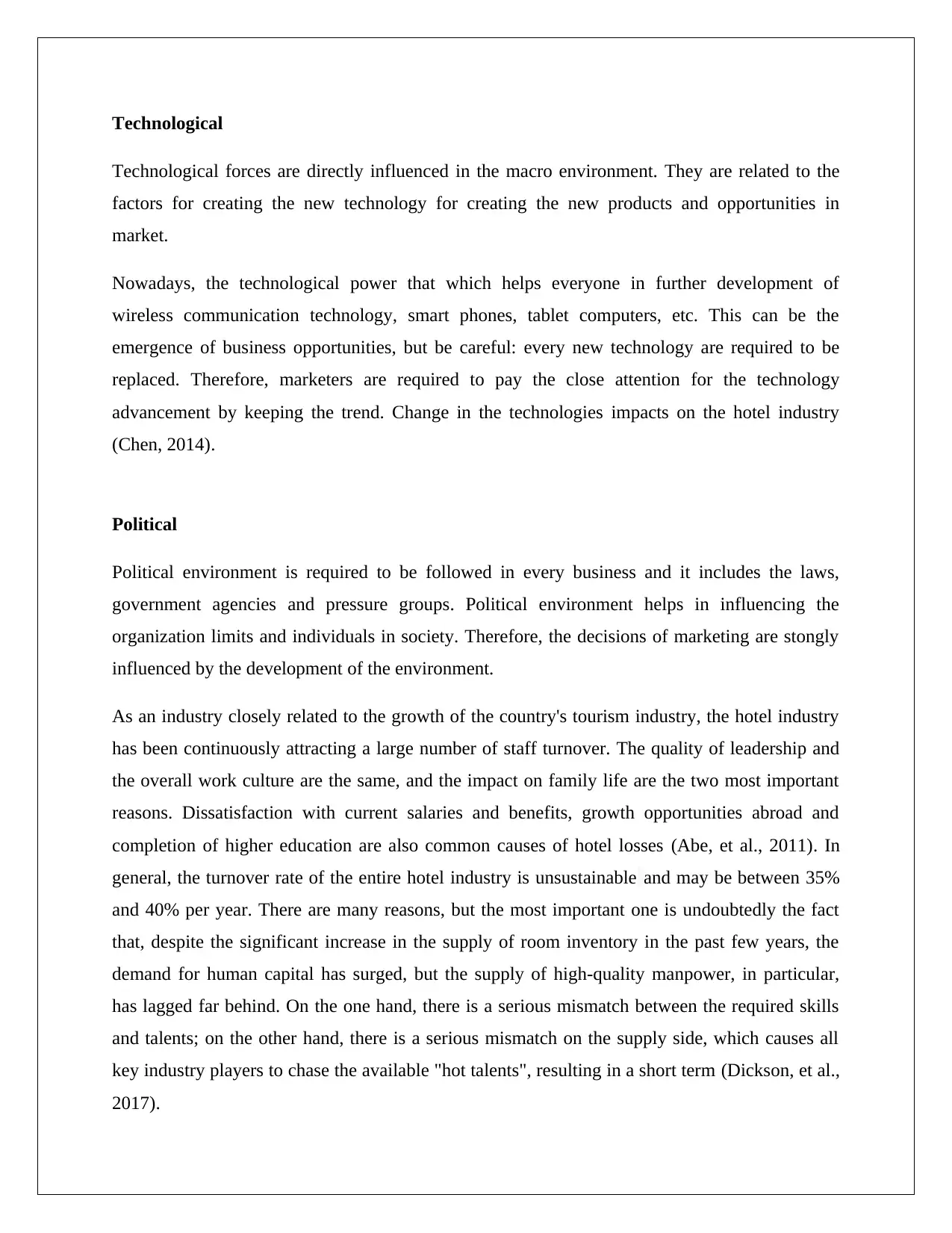
Technological
Technological forces are directly influenced in the macro environment. They are related to the
factors for creating the new technology for creating the new products and opportunities in
market.
Nowadays, the technological power that which helps everyone in further development of
wireless communication technology, smart phones, tablet computers, etc. This can be the
emergence of business opportunities, but be careful: every new technology are required to be
replaced. Therefore, marketers are required to pay the close attention for the technology
advancement by keeping the trend. Change in the technologies impacts on the hotel industry
(Chen, 2014).
Political
Political environment is required to be followed in every business and it includes the laws,
government agencies and pressure groups. Political environment helps in influencing the
organization limits and individuals in society. Therefore, the decisions of marketing are stongly
influenced by the development of the environment.
As an industry closely related to the growth of the country's tourism industry, the hotel industry
has been continuously attracting a large number of staff turnover. The quality of leadership and
the overall work culture are the same, and the impact on family life are the two most important
reasons. Dissatisfaction with current salaries and benefits, growth opportunities abroad and
completion of higher education are also common causes of hotel losses (Abe, et al., 2011). In
general, the turnover rate of the entire hotel industry is unsustainable and may be between 35%
and 40% per year. There are many reasons, but the most important one is undoubtedly the fact
that, despite the significant increase in the supply of room inventory in the past few years, the
demand for human capital has surged, but the supply of high-quality manpower, in particular,
has lagged far behind. On the one hand, there is a serious mismatch between the required skills
and talents; on the other hand, there is a serious mismatch on the supply side, which causes all
key industry players to chase the available "hot talents", resulting in a short term (Dickson, et al.,
2017).
Technological forces are directly influenced in the macro environment. They are related to the
factors for creating the new technology for creating the new products and opportunities in
market.
Nowadays, the technological power that which helps everyone in further development of
wireless communication technology, smart phones, tablet computers, etc. This can be the
emergence of business opportunities, but be careful: every new technology are required to be
replaced. Therefore, marketers are required to pay the close attention for the technology
advancement by keeping the trend. Change in the technologies impacts on the hotel industry
(Chen, 2014).
Political
Political environment is required to be followed in every business and it includes the laws,
government agencies and pressure groups. Political environment helps in influencing the
organization limits and individuals in society. Therefore, the decisions of marketing are stongly
influenced by the development of the environment.
As an industry closely related to the growth of the country's tourism industry, the hotel industry
has been continuously attracting a large number of staff turnover. The quality of leadership and
the overall work culture are the same, and the impact on family life are the two most important
reasons. Dissatisfaction with current salaries and benefits, growth opportunities abroad and
completion of higher education are also common causes of hotel losses (Abe, et al., 2011). In
general, the turnover rate of the entire hotel industry is unsustainable and may be between 35%
and 40% per year. There are many reasons, but the most important one is undoubtedly the fact
that, despite the significant increase in the supply of room inventory in the past few years, the
demand for human capital has surged, but the supply of high-quality manpower, in particular,
has lagged far behind. On the one hand, there is a serious mismatch between the required skills
and talents; on the other hand, there is a serious mismatch on the supply side, which causes all
key industry players to chase the available "hot talents", resulting in a short term (Dickson, et al.,
2017).
Paraphrase This Document
Need a fresh take? Get an instant paraphrase of this document with our AI Paraphraser
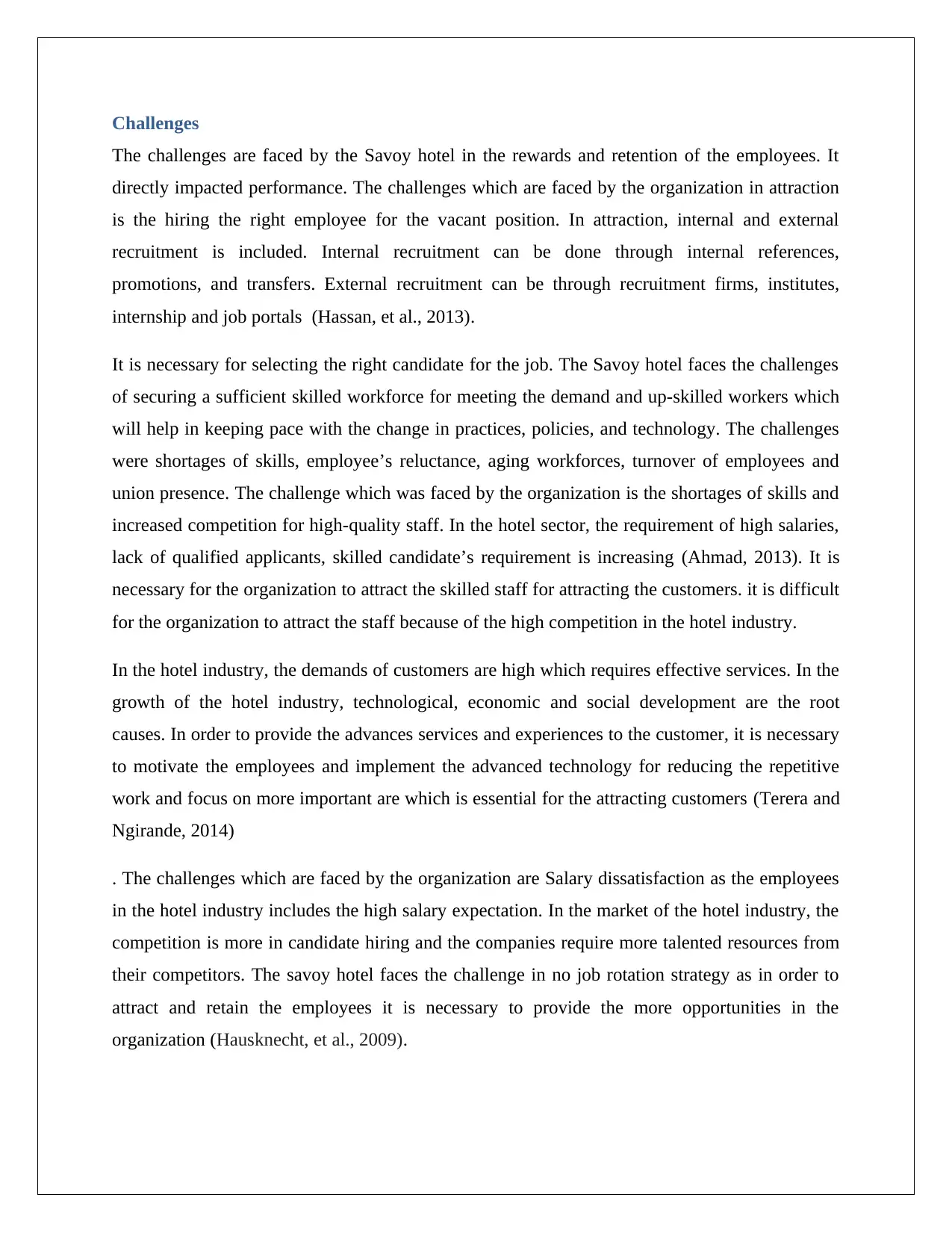
Challenges
The challenges are faced by the Savoy hotel in the rewards and retention of the employees. It
directly impacted performance. The challenges which are faced by the organization in attraction
is the hiring the right employee for the vacant position. In attraction, internal and external
recruitment is included. Internal recruitment can be done through internal references,
promotions, and transfers. External recruitment can be through recruitment firms, institutes,
internship and job portals (Hassan, et al., 2013).
It is necessary for selecting the right candidate for the job. The Savoy hotel faces the challenges
of securing a sufficient skilled workforce for meeting the demand and up-skilled workers which
will help in keeping pace with the change in practices, policies, and technology. The challenges
were shortages of skills, employee’s reluctance, aging workforces, turnover of employees and
union presence. The challenge which was faced by the organization is the shortages of skills and
increased competition for high-quality staff. In the hotel sector, the requirement of high salaries,
lack of qualified applicants, skilled candidate’s requirement is increasing (Ahmad, 2013). It is
necessary for the organization to attract the skilled staff for attracting the customers. it is difficult
for the organization to attract the staff because of the high competition in the hotel industry.
In the hotel industry, the demands of customers are high which requires effective services. In the
growth of the hotel industry, technological, economic and social development are the root
causes. In order to provide the advances services and experiences to the customer, it is necessary
to motivate the employees and implement the advanced technology for reducing the repetitive
work and focus on more important are which is essential for the attracting customers (Terera and
Ngirande, 2014)
. The challenges which are faced by the organization are Salary dissatisfaction as the employees
in the hotel industry includes the high salary expectation. In the market of the hotel industry, the
competition is more in candidate hiring and the companies require more talented resources from
their competitors. The savoy hotel faces the challenge in no job rotation strategy as in order to
attract and retain the employees it is necessary to provide the more opportunities in the
organization (Hausknecht, et al., 2009).
The challenges are faced by the Savoy hotel in the rewards and retention of the employees. It
directly impacted performance. The challenges which are faced by the organization in attraction
is the hiring the right employee for the vacant position. In attraction, internal and external
recruitment is included. Internal recruitment can be done through internal references,
promotions, and transfers. External recruitment can be through recruitment firms, institutes,
internship and job portals (Hassan, et al., 2013).
It is necessary for selecting the right candidate for the job. The Savoy hotel faces the challenges
of securing a sufficient skilled workforce for meeting the demand and up-skilled workers which
will help in keeping pace with the change in practices, policies, and technology. The challenges
were shortages of skills, employee’s reluctance, aging workforces, turnover of employees and
union presence. The challenge which was faced by the organization is the shortages of skills and
increased competition for high-quality staff. In the hotel sector, the requirement of high salaries,
lack of qualified applicants, skilled candidate’s requirement is increasing (Ahmad, 2013). It is
necessary for the organization to attract the skilled staff for attracting the customers. it is difficult
for the organization to attract the staff because of the high competition in the hotel industry.
In the hotel industry, the demands of customers are high which requires effective services. In the
growth of the hotel industry, technological, economic and social development are the root
causes. In order to provide the advances services and experiences to the customer, it is necessary
to motivate the employees and implement the advanced technology for reducing the repetitive
work and focus on more important are which is essential for the attracting customers (Terera and
Ngirande, 2014)
. The challenges which are faced by the organization are Salary dissatisfaction as the employees
in the hotel industry includes the high salary expectation. In the market of the hotel industry, the
competition is more in candidate hiring and the companies require more talented resources from
their competitors. The savoy hotel faces the challenge in no job rotation strategy as in order to
attract and retain the employees it is necessary to provide the more opportunities in the
organization (Hausknecht, et al., 2009).

There are various factors which affects the employee retention are career path which helps in
keeping the employees for longer duration in the organization. Good compensation and benefits
are higher priority for the employees which is the major for effecting the employee retention.
Personal and professional development opportunities like training, career development, and
Performance management Constitute valuable reward employees. But the value of these the
reward for the organization is not sure. From the employer Views, personal and Good
professional development only it enables workers to obtain Value-added specific skills enterprise
(Mandhanya, 2015). Valuable skills are those for an organization Unique features that
competitors cannot provide Copy-thus making it affordable for employers Competitive
Advantage.
The hotel industry is changing. Managers face difficulties with a constantly changing workforce.
Organizations serving the hotel industry require the best possible talent for serving the
customers. Continued competition in various organizations creates problems for employees to
stay. Skilled employees can leave the organization for better opportunities. Providing employees
with appropriate facilities may lead to job satisfaction (Mensah, 2014).
In the hotel industry, human factors are the key. Employee turnover will damage the company's
interests in many ways. Time, money, talents or skills are all negatively affected by employee
turnover. Employee turnover includes the indication for the dissatisfaction of employees within
the organization. The working environment, rules and regulations, and the relationship between
employees and superior authorities may be factors related to the retention of employees
(Majumdar, 2019). The high turnover rate of company employees indicates that the
organizational structure must be changed immediately. Reasonable salary and wages keep
employees working in the company for a long time (Terera and Ngirande, 2014).
Recommendation
The adoption of various strategies is required for managing attraction and retention. In the hotel
sector, the issue of attraction and retention is faced by the organization. For the retention of the
employees, the organization is required to start the employee recognition program. It is required
to establish HR management practices to provide support to the employees for setting and
achieving the goals. The strategies that are required to be used for attracting and retaining
keeping the employees for longer duration in the organization. Good compensation and benefits
are higher priority for the employees which is the major for effecting the employee retention.
Personal and professional development opportunities like training, career development, and
Performance management Constitute valuable reward employees. But the value of these the
reward for the organization is not sure. From the employer Views, personal and Good
professional development only it enables workers to obtain Value-added specific skills enterprise
(Mandhanya, 2015). Valuable skills are those for an organization Unique features that
competitors cannot provide Copy-thus making it affordable for employers Competitive
Advantage.
The hotel industry is changing. Managers face difficulties with a constantly changing workforce.
Organizations serving the hotel industry require the best possible talent for serving the
customers. Continued competition in various organizations creates problems for employees to
stay. Skilled employees can leave the organization for better opportunities. Providing employees
with appropriate facilities may lead to job satisfaction (Mensah, 2014).
In the hotel industry, human factors are the key. Employee turnover will damage the company's
interests in many ways. Time, money, talents or skills are all negatively affected by employee
turnover. Employee turnover includes the indication for the dissatisfaction of employees within
the organization. The working environment, rules and regulations, and the relationship between
employees and superior authorities may be factors related to the retention of employees
(Majumdar, 2019). The high turnover rate of company employees indicates that the
organizational structure must be changed immediately. Reasonable salary and wages keep
employees working in the company for a long time (Terera and Ngirande, 2014).
Recommendation
The adoption of various strategies is required for managing attraction and retention. In the hotel
sector, the issue of attraction and retention is faced by the organization. For the retention of the
employees, the organization is required to start the employee recognition program. It is required
to establish HR management practices to provide support to the employees for setting and
achieving the goals. The strategies that are required to be used for attracting and retaining
⊘ This is a preview!⊘
Do you want full access?
Subscribe today to unlock all pages.

Trusted by 1+ million students worldwide
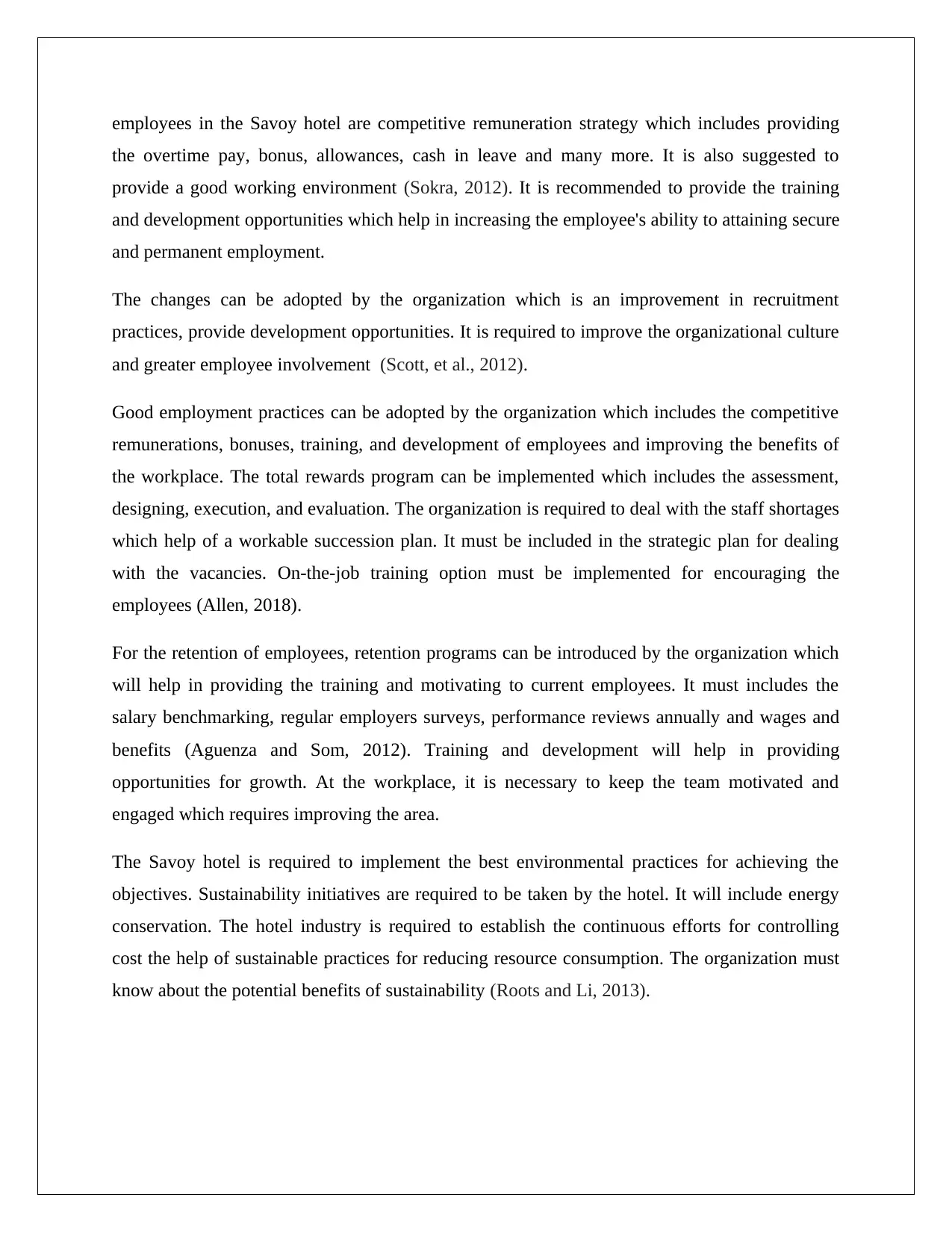
employees in the Savoy hotel are competitive remuneration strategy which includes providing
the overtime pay, bonus, allowances, cash in leave and many more. It is also suggested to
provide a good working environment (Sokra, 2012). It is recommended to provide the training
and development opportunities which help in increasing the employee's ability to attaining secure
and permanent employment.
The changes can be adopted by the organization which is an improvement in recruitment
practices, provide development opportunities. It is required to improve the organizational culture
and greater employee involvement (Scott, et al., 2012).
Good employment practices can be adopted by the organization which includes the competitive
remunerations, bonuses, training, and development of employees and improving the benefits of
the workplace. The total rewards program can be implemented which includes the assessment,
designing, execution, and evaluation. The organization is required to deal with the staff shortages
which help of a workable succession plan. It must be included in the strategic plan for dealing
with the vacancies. On-the-job training option must be implemented for encouraging the
employees (Allen, 2018).
For the retention of employees, retention programs can be introduced by the organization which
will help in providing the training and motivating to current employees. It must includes the
salary benchmarking, regular employers surveys, performance reviews annually and wages and
benefits (Aguenza and Som, 2012). Training and development will help in providing
opportunities for growth. At the workplace, it is necessary to keep the team motivated and
engaged which requires improving the area.
The Savoy hotel is required to implement the best environmental practices for achieving the
objectives. Sustainability initiatives are required to be taken by the hotel. It will include energy
conservation. The hotel industry is required to establish the continuous efforts for controlling
cost the help of sustainable practices for reducing resource consumption. The organization must
know about the potential benefits of sustainability (Roots and Li, 2013).
the overtime pay, bonus, allowances, cash in leave and many more. It is also suggested to
provide a good working environment (Sokra, 2012). It is recommended to provide the training
and development opportunities which help in increasing the employee's ability to attaining secure
and permanent employment.
The changes can be adopted by the organization which is an improvement in recruitment
practices, provide development opportunities. It is required to improve the organizational culture
and greater employee involvement (Scott, et al., 2012).
Good employment practices can be adopted by the organization which includes the competitive
remunerations, bonuses, training, and development of employees and improving the benefits of
the workplace. The total rewards program can be implemented which includes the assessment,
designing, execution, and evaluation. The organization is required to deal with the staff shortages
which help of a workable succession plan. It must be included in the strategic plan for dealing
with the vacancies. On-the-job training option must be implemented for encouraging the
employees (Allen, 2018).
For the retention of employees, retention programs can be introduced by the organization which
will help in providing the training and motivating to current employees. It must includes the
salary benchmarking, regular employers surveys, performance reviews annually and wages and
benefits (Aguenza and Som, 2012). Training and development will help in providing
opportunities for growth. At the workplace, it is necessary to keep the team motivated and
engaged which requires improving the area.
The Savoy hotel is required to implement the best environmental practices for achieving the
objectives. Sustainability initiatives are required to be taken by the hotel. It will include energy
conservation. The hotel industry is required to establish the continuous efforts for controlling
cost the help of sustainable practices for reducing resource consumption. The organization must
know about the potential benefits of sustainability (Roots and Li, 2013).
Paraphrase This Document
Need a fresh take? Get an instant paraphrase of this document with our AI Paraphraser
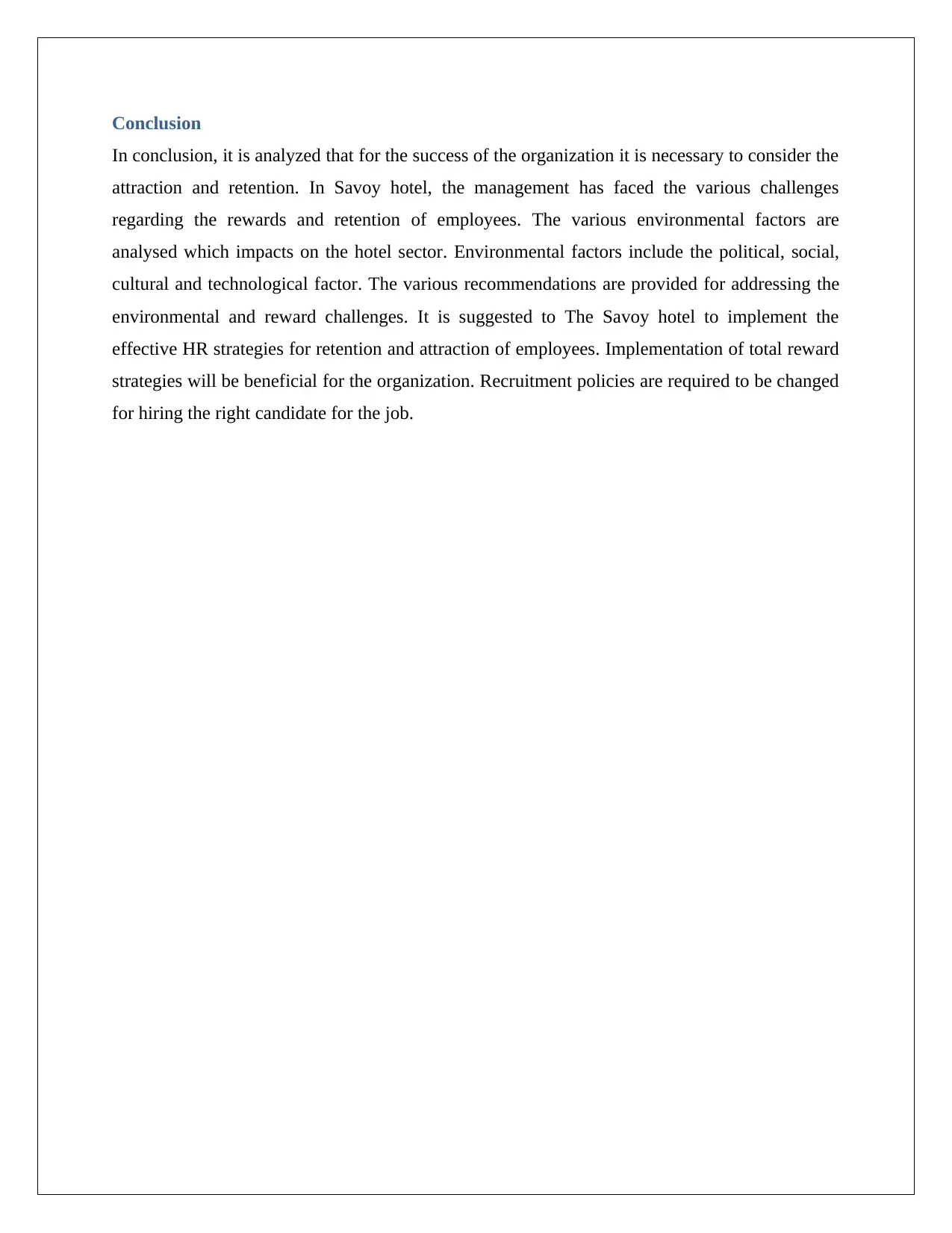
Conclusion
In conclusion, it is analyzed that for the success of the organization it is necessary to consider the
attraction and retention. In Savoy hotel, the management has faced the various challenges
regarding the rewards and retention of employees. The various environmental factors are
analysed which impacts on the hotel sector. Environmental factors include the political, social,
cultural and technological factor. The various recommendations are provided for addressing the
environmental and reward challenges. It is suggested to The Savoy hotel to implement the
effective HR strategies for retention and attraction of employees. Implementation of total reward
strategies will be beneficial for the organization. Recruitment policies are required to be changed
for hiring the right candidate for the job.
In conclusion, it is analyzed that for the success of the organization it is necessary to consider the
attraction and retention. In Savoy hotel, the management has faced the various challenges
regarding the rewards and retention of employees. The various environmental factors are
analysed which impacts on the hotel sector. Environmental factors include the political, social,
cultural and technological factor. The various recommendations are provided for addressing the
environmental and reward challenges. It is suggested to The Savoy hotel to implement the
effective HR strategies for retention and attraction of employees. Implementation of total reward
strategies will be beneficial for the organization. Recruitment policies are required to be changed
for hiring the right candidate for the job.
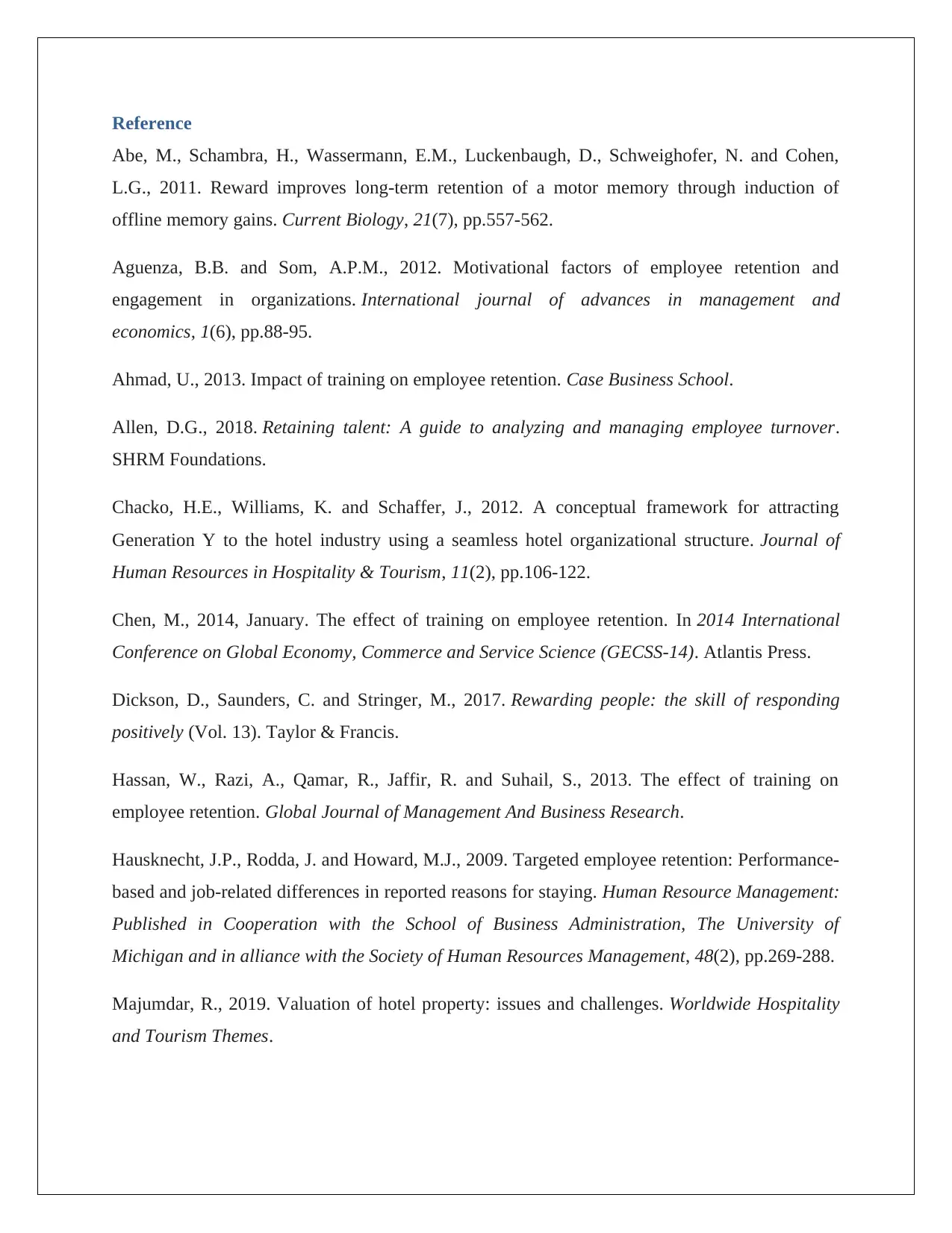
Reference
Abe, M., Schambra, H., Wassermann, E.M., Luckenbaugh, D., Schweighofer, N. and Cohen,
L.G., 2011. Reward improves long-term retention of a motor memory through induction of
offline memory gains. Current Biology, 21(7), pp.557-562.
Aguenza, B.B. and Som, A.P.M., 2012. Motivational factors of employee retention and
engagement in organizations. International journal of advances in management and
economics, 1(6), pp.88-95.
Ahmad, U., 2013. Impact of training on employee retention. Case Business School.
Allen, D.G., 2018. Retaining talent: A guide to analyzing and managing employee turnover.
SHRM Foundations.
Chacko, H.E., Williams, K. and Schaffer, J., 2012. A conceptual framework for attracting
Generation Y to the hotel industry using a seamless hotel organizational structure. Journal of
Human Resources in Hospitality & Tourism, 11(2), pp.106-122.
Chen, M., 2014, January. The effect of training on employee retention. In 2014 International
Conference on Global Economy, Commerce and Service Science (GECSS-14). Atlantis Press.
Dickson, D., Saunders, C. and Stringer, M., 2017. Rewarding people: the skill of responding
positively (Vol. 13). Taylor & Francis.
Hassan, W., Razi, A., Qamar, R., Jaffir, R. and Suhail, S., 2013. The effect of training on
employee retention. Global Journal of Management And Business Research.
Hausknecht, J.P., Rodda, J. and Howard, M.J., 2009. Targeted employee retention: Performance‐
based and job‐related differences in reported reasons for staying. Human Resource Management:
Published in Cooperation with the School of Business Administration, The University of
Michigan and in alliance with the Society of Human Resources Management, 48(2), pp.269-288.
Majumdar, R., 2019. Valuation of hotel property: issues and challenges. Worldwide Hospitality
and Tourism Themes.
Abe, M., Schambra, H., Wassermann, E.M., Luckenbaugh, D., Schweighofer, N. and Cohen,
L.G., 2011. Reward improves long-term retention of a motor memory through induction of
offline memory gains. Current Biology, 21(7), pp.557-562.
Aguenza, B.B. and Som, A.P.M., 2012. Motivational factors of employee retention and
engagement in organizations. International journal of advances in management and
economics, 1(6), pp.88-95.
Ahmad, U., 2013. Impact of training on employee retention. Case Business School.
Allen, D.G., 2018. Retaining talent: A guide to analyzing and managing employee turnover.
SHRM Foundations.
Chacko, H.E., Williams, K. and Schaffer, J., 2012. A conceptual framework for attracting
Generation Y to the hotel industry using a seamless hotel organizational structure. Journal of
Human Resources in Hospitality & Tourism, 11(2), pp.106-122.
Chen, M., 2014, January. The effect of training on employee retention. In 2014 International
Conference on Global Economy, Commerce and Service Science (GECSS-14). Atlantis Press.
Dickson, D., Saunders, C. and Stringer, M., 2017. Rewarding people: the skill of responding
positively (Vol. 13). Taylor & Francis.
Hassan, W., Razi, A., Qamar, R., Jaffir, R. and Suhail, S., 2013. The effect of training on
employee retention. Global Journal of Management And Business Research.
Hausknecht, J.P., Rodda, J. and Howard, M.J., 2009. Targeted employee retention: Performance‐
based and job‐related differences in reported reasons for staying. Human Resource Management:
Published in Cooperation with the School of Business Administration, The University of
Michigan and in alliance with the Society of Human Resources Management, 48(2), pp.269-288.
Majumdar, R., 2019. Valuation of hotel property: issues and challenges. Worldwide Hospitality
and Tourism Themes.
⊘ This is a preview!⊘
Do you want full access?
Subscribe today to unlock all pages.

Trusted by 1+ million students worldwide

Mandhanya, Y., 2015. Training and development strategies: Motivational tool for increasing
employee retention. Training & Development Journal, 6(1), pp.15-20.
Mensah, I., 2014. Environmental management practices in US hotels. Retrieved November, 7,
p.2008.
Roots, R.K. and Li, L.C., 2013. Recruitment and retention of occupational therapists and
physiotherapists in rural regions: a meta-synthesis. BMC health services research, 13(1), p.59.
Scott, D., McMullen, T. and Royal, M., 2012. Retention of key talent and the role of
rewards. WorldatWork Journal, 21(4), pp.58-70.
Sokro, E., 2012. Impact of employer branding on employee attraction and retention. European
Journal of Business and Management, 4(18), pp.164-173.
Terera, S.R. and Ngirande, H., 2014. The impact of rewards on job satisfaction and employee
retention. Mediterranean Journal of Social Sciences, 5(1), p.481.
employee retention. Training & Development Journal, 6(1), pp.15-20.
Mensah, I., 2014. Environmental management practices in US hotels. Retrieved November, 7,
p.2008.
Roots, R.K. and Li, L.C., 2013. Recruitment and retention of occupational therapists and
physiotherapists in rural regions: a meta-synthesis. BMC health services research, 13(1), p.59.
Scott, D., McMullen, T. and Royal, M., 2012. Retention of key talent and the role of
rewards. WorldatWork Journal, 21(4), pp.58-70.
Sokro, E., 2012. Impact of employer branding on employee attraction and retention. European
Journal of Business and Management, 4(18), pp.164-173.
Terera, S.R. and Ngirande, H., 2014. The impact of rewards on job satisfaction and employee
retention. Mediterranean Journal of Social Sciences, 5(1), p.481.
1 out of 10
Related Documents
Your All-in-One AI-Powered Toolkit for Academic Success.
+13062052269
info@desklib.com
Available 24*7 on WhatsApp / Email
![[object Object]](/_next/static/media/star-bottom.7253800d.svg)
Unlock your academic potential
Copyright © 2020–2025 A2Z Services. All Rights Reserved. Developed and managed by ZUCOL.





